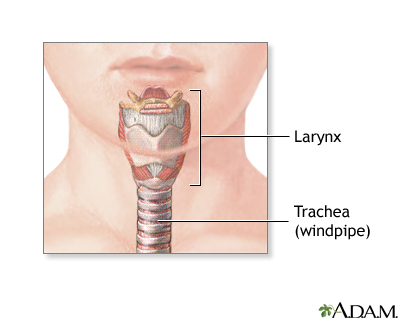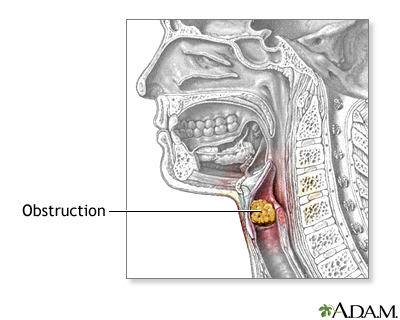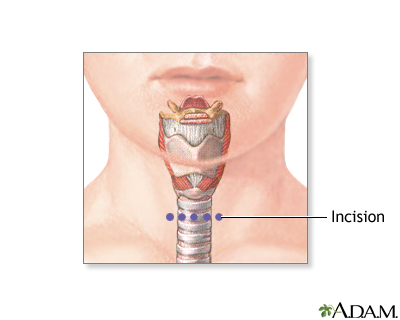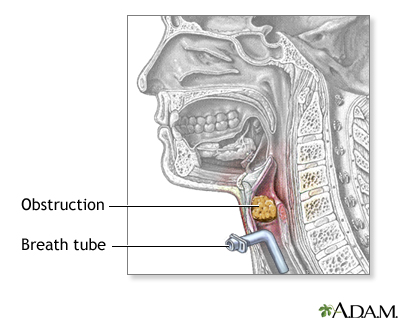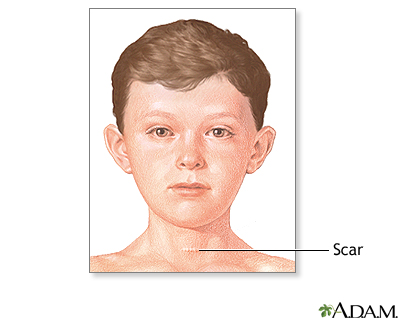Tracheostomy
Normal anatomy
|
|
The trachea, or windpipe, carries air from the larynx to the bronchi and lungs.
|
Indications
|
|
The indications for tracheostomy include:
- Prolonged intubation during the course of a critical illness
- Subglottic stenosis from prior trauma
- Obstruction from obesity for sleep apnea
- Congenital (inherited) abnormality of the larynx or trachea
- Severe neck or mouth injuries
- Inhalation of corrosive material smoke or steam
- Presence of a large foreign body that occludes the airway
- Paralysis of the muscles that affect swallowing causing a danger of aspiration
- Long term unconsciousness or coma
|
Incision
|
|
General anesthesia is used and the patient is deep asleep and pain-free. The neck is cleaned and draped. Incisions are made to expose the tough cartilage rings that make up the outer wall of the trachea.
|
Procedure
|
|
The surgeon then cuts two of these rings and inserts a tracheostomy tube.
|
Aftercare
|
|
Most patients require 1 to 3 days to adapt to breathing through a tracheostomy tube. Communication will require adjustment. Initially, it may be impossible for the patient to talk or make sounds. After training and practice, most patients can learn to talk with a trach tube.
Patients or parents learn how to take care of the tracheostomy during the hospital stay. Home-care service may also be available. Normal lifestyles are encouraged and most activities can be resumed. When outside a loose covering for the tracheostomy stoma (hole) (a scarf or other protection) is recommended. Other safety precautions regarding exposure to water, aerosols, powder or food particles must be adhered to.
After treatment of the underlying problem that necessitated the tracheostomy tube initially, the tube is easily removed, and the hole heals quickly, with only a small scar.
|

Review Date:1/22/2023
Reviewed By:Denis Hadjiliadis, MD, MHS, Paul F. Harron, Jr. Professor of Medicine, Pulmonary, Allergy, and Critical Care, Perelman School of Medicine, University of Pennsylvania, Philadelphia, PA. Also reviewed by David C. Dugdale, MD, Medical Director, Brenda Conaway, Editorial Director, and the A.D.A.M. Editorial team.
The information provided herein should not be used during any medical emergency
or for the diagnosis or treatment of any medical condition. A licensed medical professional
should be consulted for diagnosis and treatment of any and all medical conditions. Call 911
for all medical emergencies. Links to other sites are provided for information only -- they
do not constitute endorsements of those other sites. © 1997-A.D.A.M., Inc. Any duplication or distribution of the information contained herein is strictly prohibited.
The Agency for Health Care Administration (Agency) and this website do not claim the information on, or referred to by, this site is error free. This site may include links to websites of other government agencies or private groups. Our Agency and this website do not control such sites and are not responsible for their content. Reference to or links to any other group, product, service, or information does not mean our Agency or this website approves of that group, product, service, or information.
Additionally, while health information provided through this website may be a valuable resource for the public, it is not designed to offer medical advice. Talk with your doctor about medical care questions you may have.

